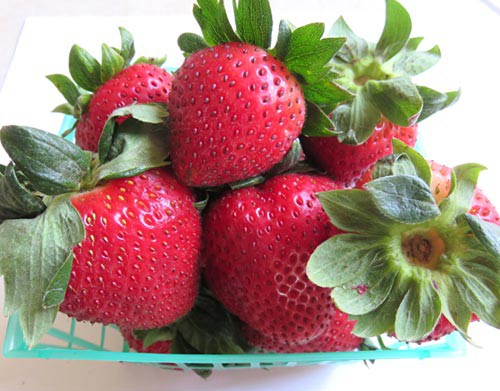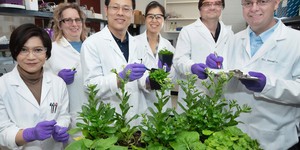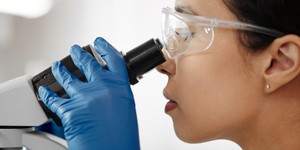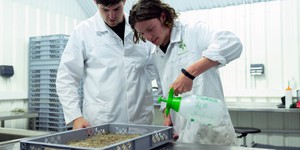Abstract
Fuzzy things are often cute, but not when that fuzziness is mold on your strawberry—yuck! Companies look for natural, plant-based ways to protect the berries from mold when they are in the store, waiting for you to purchase them. Would washing them in aloe vera juice protect strawberries from mold? Do this project and find out!Summary

Objective
Determine if washing strawberries in aloe vera juice protects strawberries from mold.
Introduction
Fuzziness can be cute, but as shown in Figure 1, it is not always cute.
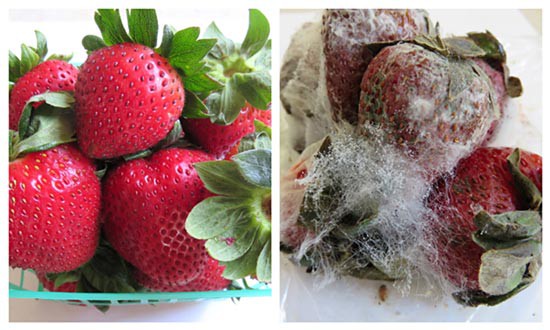 Image Credit: Sabine De Brabandere, Science Buddies / Science Buddies
Image Credit: Sabine De Brabandere, Science Buddies / Science Buddies
Figure 1. Fresh strawberries are yummy; moldy strawberries are not!
Have you noticed that the juicy, yummy strawberries you get from the grocery store or farmer's market tend to turn moldy if you do not eat them quickly enough? On average, for each 10 lbs. (pounds) of strawberries delivered to supermarkets, about 1 lb. cannot be sold due to spoilage and other reasons (numbers come from the USDA article quoted in the Bibliography). Shipping and storing fresh fruits and vegetables is a big industry involving a lot of money. It falls under a field of research called economic botany. Economic botany is the study of how plants can be used to make products that are important to people, like food, medicine, and shelter. Usually that starts with seeing how the special characteristics of a plant can help solve a problem. The aloe vera plant shown in Figure 2 is well known in economic botany.
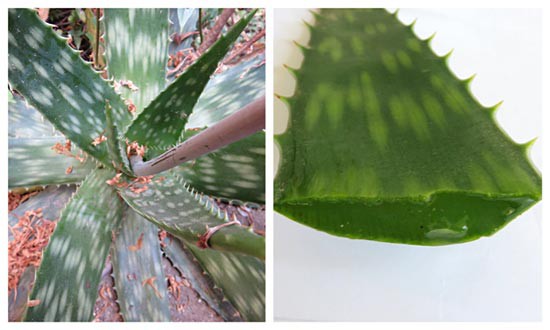 Image Credit: Sabine De Brabandere, Science Buddies / Science Buddies
Image Credit: Sabine De Brabandere, Science Buddies / Science Buddies
Figure 2. The aloe vera plant has thick leaves. The gel inside the leaves is used in commercial products (which means a product intended for making money), like products for sunburn relief.
The gel inside the thick, fleshy leaves of this plant is used in various commercial products, from body lotions and creams to healthy drinks and juices. People believe the gel in the leaves has healing, disinfecting, and soothing properties, and that it can help with various medical conditions. Scientists are studying the plant in more detail.
Some people also think the gel in the aloe vera plant has anti-fungal properties, meaning it slows down the growth and spread of fungi. Fungi (plural for fungus) are living organisms that are different from plants, animals, or bacteria. Mold is a specific type of fungus. It can be identified as fuzzy or hairy growth that occurs on damp, decaying biological matter. You may have seen it on berries, bread, or cheese that turned bad. It grows faster in a moist or damp environment. It most often has an earth-like smell and is most often white, green, blue, or black. It flourishes at temperatures ranging from 70 to 90 degrees Fahrenheit. Mold growth generally slows down at refrigerator temperature. Some examples of mold growing on strawberries are shown in Figure 3.
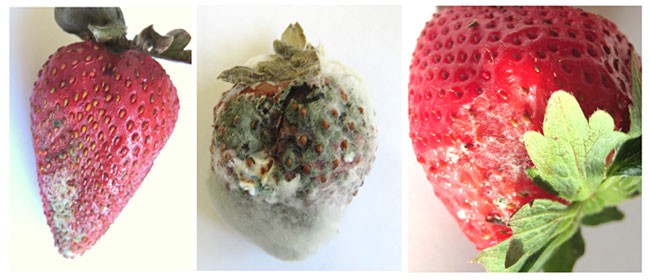 Image Credit: Sabine De Brabandere, Science Buddies / Science Buddies
Image Credit: Sabine De Brabandere, Science Buddies / Science Buddies
Figure 3. Examples of mold growing on strawberry.
If the aloe gel protects against specific fungi, would it protect strawberries against mold growth?
In this project, you will wash some samples of strawberries in aloe vera juice, and other samples in water. Aloe vera juice is made by combining aloe gel with water and sometimes other ingredients to change the flavor of the gel and water combination. Do you think the strawberries washed in aloe vera juice will be free of mold for a longer time? Get ready to find out!
Terms and Concepts
- Economic botany
- Aloe vera plant
- Anti-fungal
- Fungi
- Mold
- Trial
- Cross-contamination
Questions
- Why would companies search for plant-based products to keep strawberries fresh longer?
- Have you seen examples of moldy food in your house? Were these items stored in a cool or in a warmer area? Were they stored in a dry or in a damp environment?
- Why do you think aloe vera juice might help protect strawberries against mold?
Bibliography
- Society for General Microbiology. (2015). Fungi. Retrieved May 20, 2015.
- Kew Botanical Gardens. (n.d.). Aloe Vera. Retrieved May 20, 2015.
- Cudzby, J.; Wells, H.; Axtman, B.; Mickey, J. (2009, March). Supermarket Loss Estimates for Fresh Fruit, Vegetables, Meat, Poultry and Seafood and Their Use in the ERS Loss-Adjusted Food Availability Data. Retrieved May 20, 2015.
- Jerome, E. (2011, March 21). Fighting Fungus with the Aloe Plant. Retrieved May 20, 2015.
For help creating graphs, try this website:
- National Center for Education Statistics, (n.d.). Create a Graph. Retrieved June 25, 2020.
Materials and Equipment
- Drinking glasses, with wide top opening (2)
- Water
- Sticky notes
- Pen
- Aloe vera juice (1 L), like this whole leaf aloe vera juice, available from
Amazon.com.
- Choose a juice consisting of 90% or more aloe vera leaf juice.
- Paper towels (1 roll)
- Fresh strawberries (6 pints or 4 ½ lbs. of fresh strawberries)
- Pint-size strawberry containers, plastic (6). Note that you may need to purchase or find containers separately if you purchase your strawberries in a single, large container. You can find these containers at your grocery store or farmer's market. Just ask the produce department or farmer and say it is for a science project, and they may give you a few for free.
- Dishwashing soap
- Sink
- Kitchen towel
- Plastic wrap (1/2 roll)
- Newspaper
- Disposable gloves (40 pairs), like these extra-small gloves, available from Amazon.com. Also available at your local drug store or pharmacy. Warning: If you are allergic to latex, use nitrile or polyethylene gloves.
- Lab notebook
- Graph paper
- Optional: Camera
Disclaimer: Science Buddies participates in affiliate programs with Home Science Tools, Amazon.com, Carolina Biological, and Jameco Electronics. Proceeds from the affiliate programs help support Science Buddies, a 501(c)(3) public charity, and keep our resources free for everyone. Our top priority is student learning. If you have any comments (positive or negative) related to purchases you've made for science projects from recommendations on our site, please let us know. Write to us at scibuddy@sciencebuddies.org.
Experimental Procedure
Preparation
To see if washing strawberries in aloe vera juice protects them from mold, you will wash a sample in aloe vera juice and a similar sample in water, pack them in a pint-size strawberry container, and watch how they do over time.
You will repeat this test three times, each time with a new sample of strawberries. Scientists call this three trials. Performing several trials makes sure no accidental mistakes or happenings messed up the results.
It is best to start all your trials at the same time. If this feels like a lot of work at once, it is fine to do the trials a few hours apart, or ask for help. Getting them all started on the same day will make analyzing your data much easier.
Plan your test so you can examine the strawberries each day for up to seven days after you washed and packed the strawberries.
Setting up the Experiment
- Fill a wide glass with clean water. The glass should have enough water in it to wash a strawberry, but not so much that it overflows with a strawberry inside.
- Add a sticky note to the glass reading "Water."
- Fill a similar glass in a similar way with aloe vera juice.
- Add a sticky note to the glass reading "Aloe Vera Juice," as shown in Figure 4.
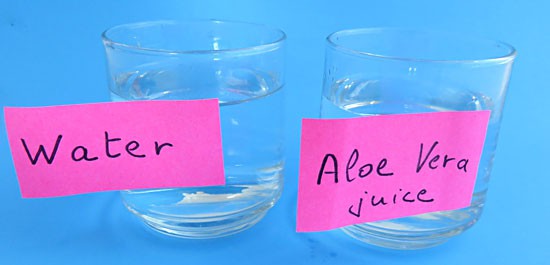 Image Credit: Sabine De Brabandere, Science Buddies / Science Buddies
Image Credit: Sabine De Brabandere, Science Buddies / Science Buddies
Figure 4. Strawberries will be washed in glasses filled with water and aloe vera juice. Sticky notes will prevent you from accidentally mixing up the glasses since the liquids look the same.
- Take two pints of strawberries (about 1 ½ lbs.;
see the Technical Note for conversion rates to estimated number of strawberries) and separate them into two groups of 12 strawberries each:
- Put down two paper towels, label them as "Group 1" and "Group 2."
- Take a strawberry and place it in the first group.
- Find a strawberry similar in ripeness and size and put it in the second group.
- Repeat steps b. and c. until you have 12 strawberries in each group.
- You can keep any strawberries that are leftover for your next trial or wash and eat them!
- Stack three fresh paper towels on your work surface. Add a sticky note reading "Water" on the top paper towel.
- Dunk the strawberries of group 1, one at a time, in the water-filled glass. If dirt is stuck on the berry, carefully rub it off with your finger. Put all of the washed strawberries down on the stack of paper towels labeled "Water."
- Repeat step 6, now adding a sticky note reading "Aloe Vera Juice" on the top paper towel.
- Repeat step 7, now washing strawberries of group 2 in the glass filled with aloe vera juice and putting them on the towels labeled "Aloe Vera Juice."
- Let all the strawberries dry.
- While you wait for your strawberries to dry, dispose of the liquids in the glasses by pouring them down the sink.
- Rinse out the sink, then fill it with warm water, then add a few drops of dishwashing soap and wash out two identical 1 pint containers. Wash the glasses as well.
- Carefully rinse off all the soapy water and wipe the containers and glasses dry with a kitchen towel.
- Create labels for your containers. Figure 5 shows an example.
- Sticky notes work well. Cut them in half if needed.
- Write the following information on the label:
- "Water" on the first label; "Aloe Vera Juice" on the second.
- "Trial 1" (Remember to change the number to 2 or 3 for following trials).
- The date you are washing and packing the strawberries.
- Stick the labels to the side of the containers. This way, liquid leaking out of the strawberries will not destroy the label.
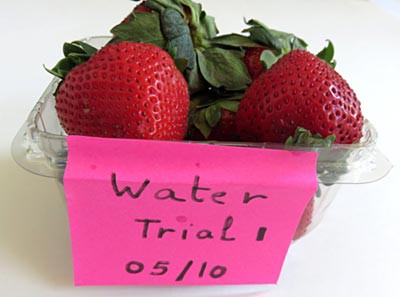 Image Credit: Sabine De Brabandere, Science Buddies / Science Buddies
Image Credit: Sabine De Brabandere, Science Buddies / Science Buddies
Figure 5. Containers are first washed, then labeled and filled with strawberries.
- Once your strawberries are dry, fill the containers with 12 strawberries. Strawberries washed in water go in the container labeled "Water." Strawberries washed in aloe vera juice go in the container labeled "Aloe Vera Juice."
- Wrap each filled container in two layers of plastic wrap. You are wrapping the containers to keep the moisture inside the packages. Mold grows faster in moist conditions.
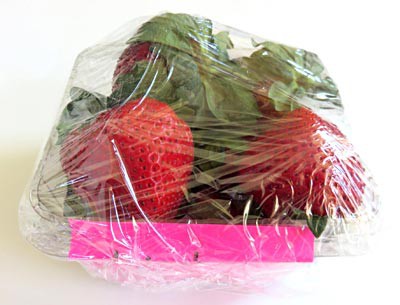 Image Credit: Sabine De Brabandere, Science Buddies / Science Buddies
Image Credit: Sabine De Brabandere, Science Buddies / Science Buddies
Figure 6. Containers are wrapped in plastic wrap to keep moisture inside.
- Find a location where the containers can stay for a few days. Avoid direct sunlight, but do not refrigerate your packed strawberries. Mold grows better at room temperature. If possible, use this same location for all trials.
- Put the containers on top of a few pages of newspaper. The newspaper will absorb any excess liquid that might drip out.
- Throw away your used paper towels.
At this point, you can continue by starting your second and third trials, or if you have decided to wait, you can do those later in the day. Keep any unused strawberries in the refrigerator until you are ready to prepare them. To start a new trial, repeat steps 1–19 again. Remember to write the new trial number on your labels: "Trial 2" for the second trial and "Trial 3" for the third set of containers.
The weight of a pint of strawberries may vary due to the fact that a pint is a measure of volume, while pounds or grams are measures of mass. In general, 1 pint of strawberries will weigh about 350 grams (g) or ¾ lbs. The number of strawberries contained in a pint-size container will largely depend on the size the strawberries. It can be as little as 10, or as much as 40 strawberries.
Making Observations
- Copy tables 1 and 2 in your lab notebook; they will help you take notes as you observe.
| Id | Number of strawberries that show no signs of mold in a container of 12 strawberries | |||||||
|---|---|---|---|---|---|---|---|---|
| Observation Day: | Day 1 | Day 2 | Day 3 | Day 4 | ||||
| Treatment: | Water | Aloe Vera Juice | Water | Aloe Vera Juice | Water | Aloe Vera Juice | Water | Aloe Vera Juice |
| Trial 1 | ||||||||
| Trial 2 | ||||||||
| Trial 3 | ||||||||
| Total | ||||||||
| Additional Observations | ||||||||
|---|---|---|---|---|---|---|---|---|
| Observation Day: | Day 1 | Day 2 | Day 3 | Day 4 | ||||
| Treatment: | Water | Aloe Vera Juice | Water | Aloe Vera Juice | Water | Aloe Vera Juice | Water | Aloe Vera Juice |
| Trial 1 | ||||||||
| Trial 2 | ||||||||
| Trial 3 | ||||||||
- After leaving the packed strawberries alone for one whole day, take the containers of strawberries, one at a time, and follow steps 3–13 to make observations.
- Put on a pair of unused disposable gloves. Set out a clean paper towel on which to put any strawberries you need to take out.
- Unwrap the container.
- Read the trial number on the label. Find this trial number in your data table like tables 1 and 2. You will write your observations on that line.
- To find the column, first read the treatment ("Water" or "Aloe Vera Juice") on the label. In your table, go to the line found in step 5 and move to the right until you get to an empty rectangle that has the correct treatment on top. Make a little mark on this rectangle with your pen so you find it again easily when it is time to write down your observations (see the following steps, 8 and 9). Do this for both tables.
- Examine the strawberries carefully.
- Has the color changed? How do the strawberries smell?
- Do the strawberries show signs of mold? Figure 7 and Figure 3 in the Introduction show pictures of moldy strawberries. As stated in the Introduction, mold is often visible as white, green, blue, or black fuzz. Mold often has an earth-like smell.
- Note: You might see other forms of decay that are different from mold. The brown spots shown in Figure 8 are an example. As you are studying if aloe vera juice protects against mold, you will only count the strawberries that do not show mold growth. Other observations can still be valid, though, and lead to a follow-up study. You can write them down in your table like Table 2.
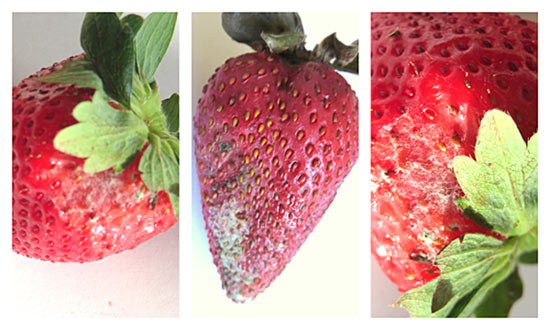 Image Credit: Sabine De Brabandere, Science Buddies / Science Buddies
Image Credit: Sabine De Brabandere, Science Buddies / Science Buddies
Figure 7. Mold on strawberries is often visible as white, green, blue, or black fuzz.
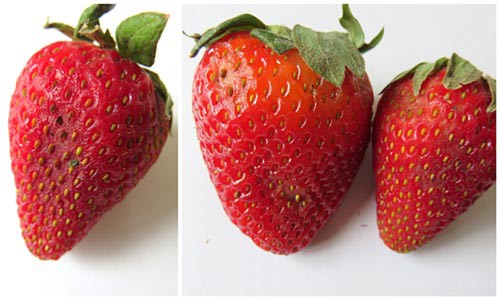 Image Credit: Sabine De Brabandere, Science Buddies / Science Buddies
Image Credit: Sabine De Brabandere, Science Buddies / Science Buddies
Figure 8. Decay on strawberries is often visible as brownish spots.
- Count the number of strawberries showing no signs of mold. Write this number in the table in the rectangle you marked in step 6. As an example, you would write "12" if none of the strawberries show mold, or "0" if all the strawberries are moldy.
- Write other observations (like "Smells like ripe strawberries", "Strawberries feel soft," or "Strawberries are dried out," etcetera) in the second table, again in the rectangle you marked in step 6. Write "None" if you have nothing special to say for that day.
- Optional: Take pictures of anything you find interesting on the strawberries. Include a sticky note in the picture indicating which strawberries this picture is of, like the one label shown in Figure 9. This will help you remember what is in the picture. You can use these pictures to decorate your science project display board.
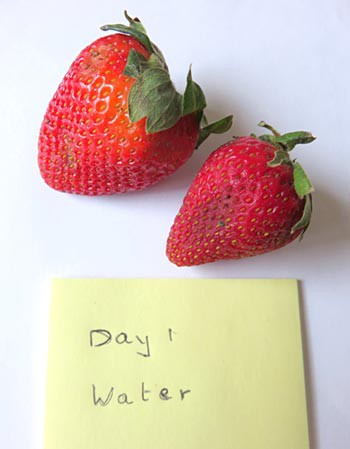 Image Credit: Sabine De Brabandere, Science Buddies / Science Buddies
Image Credit: Sabine De Brabandere, Science Buddies / Science Buddies
Figure 9. It is a good habit to place a label in the picture, to remind you of what is in the picture.
- Once all of the strawberries in a container have mold growing on them, you can throw away that container with its plastic wrap and everything, or keep it to see how the mold develops. If you open the wrap of this container at later date, make sure to clean up well. Spores might fly around and start growing on other decaying material.
- If there are still strawberries that show no sign of mold growth, put all the strawberries back into the container (including the moldy strawberries), wrap the container back into the plastic wrap and put it back onto the newspapers.
- Important Throw away your gloves and the paper towel. This will help avoid any cross-contamination or transfer of mold spores from one container to another during handling. Mold spores are the way mold reproduces.
- Repeat steps 3–13 for the other containers of strawberries until you have made observations for all packages.
- Let the strawberries sit for another full day. Change the newspaper layer with fresh newspaper as needed.
- Repeat steps 2–15 the next day.
- Repeat observations each day, until you have no more packages left. Note: You might need to add columns to your data table if not all the strawberries show mold after four days.
Analyzing Your Data
- Add up the number of moldy strawberries over your three trials, as follows.
- Add up the number of strawberries showing no signs of mold growth on day 1 for trial 1, day 1 for trial 2, and day 1 for trial 3 for the strawberries washed in water (the three numbers in a single column of your table like Table 1). This is the total number of strawberries initially washed in water that show no signs of mold after one day. Write this number in the "Total" row at the bottom of this column.
- Repeat step a. for strawberries washed in aloe vera juice.
- Repeat steps a. and b. for all the other days.
- Plot the data that you collected on a graph. You can make your graphs by hand or you can make your graphs online using Create a Graph.
- Choose a bar graph to display the total number of strawberries that show no sign of mold for day 1.
- Label the x-axis Treatment .
- Label the y-axis Number of strawberries.
- Choose 0 as minimum and 40 as maximum for your y-axis. Why do you think 0 and 40 are good numbers to choose as minimum and maximum for your y-axis? Hint: Think about how high your bar could get (like how high would the bar be if none of the strawberries show mold), then leave some room at the top of your bar.
- An example of what your bar chart might look like is shown in Figure 10.
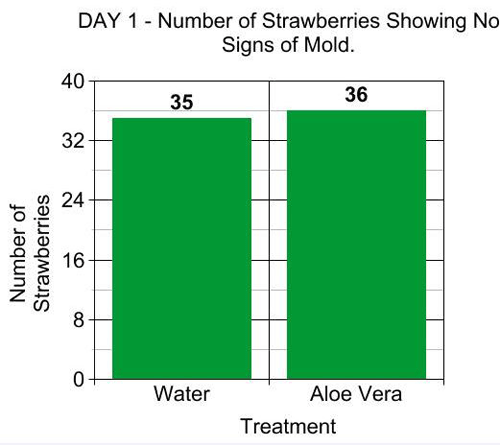 Image Credit: Sabine De Brabandere, Science Buddies / Science Buddies
Image Credit: Sabine De Brabandere, Science Buddies / Science BuddiesThe example bar graph shows two bars for separate groups of strawberries that have not shown signs of mold. The left bar shows 35 strawberries washed in water have not shown signs of mold. The right bar shows 36 strawberries washed in aloe vera juice have not shown signs of mold.
Figure 10. This bar graph shows that on day 1, 35 of the initial 36 strawberries washed in water and all of the 36 strawberries washed in aloe vera juice show no signs of mold.
- Look at your data table and find the second to last day of your observations. Note that on the last day of your observation, all of your strawberries likely showed signs of mold, so your totals would all be "0" for that day. Repeat step 2 using the data for the second to last day or the day just before all total numbers become zero.
- Choose a day in the middle, between the first and the last day of observation. Make a bar chart with the data for that day.
- Optional: Depending on your data, you might choose to make an additional graph for the day where the difference between the totals for strawberries washed in water and strawberries washed in aloe vera juice is the biggest.
- Based on your data, did the strawberries washed in water mold faster than the strawberries washed in aloe vera juice? Is the difference small or large?
- Based on your data, did you notice any other aspects of strawberries (like taste, smell, look) that were different for the strawberries washed in water compared to those washed in aloe vera juice?
- Based on your data, would you say that washing strawberries in aloe vera juice protects them from mold?
- The Introduction states that mold is a kind of fungus. Based on your data, would you say aloe vera is antifungal? Do you think it would it be worth making products from it? What kind of products, based on your data, can you imagine a company creating?
Ask an Expert
Global Connections
The United Nations Sustainable Development Goals (UNSDGs) are a blueprint to achieve a better and more sustainable future for all.
Variations
- This project involves using strawberries. You can experiment with other berries, other food products, or even other objects like moist cardboard or wood.
- In this procedure, you used uncut strawberries. Would cut-up strawberries stay fresh longer after washing them in aloe vera juice compared to washing them in water? Would you dunk them in aloe vera juice again after they have been cut, or only before?
- You could compare different packing material. Would an open container that allows plenty of air flow preserve strawberries better than an air tight container? What would be good ways to pack cut-up strawberries?
- In this project, moldy strawberries were put back with the other strawberries until all strawberries in the container showed signs of mold. As a variation, study what happens if you remove individual moldy strawberries from containers as soon as you see signs of mold. Does that slow down the appearance of mold on the other strawberries in the container? What happens if, in addition, you wash the containers each time you check on the strawberries?
- In this project, you leave the strawberries out at room temperature. Would aloe vera juice also be useful as an antifungal for strawberries kept in the refrigerator?
- You can also study how much cooling to refrigerator temperature slows down mold growth with respect to strawberries left at room temperature.
- Check out following project idea for a different strawberry conservation technique: Save Those Spoiling Strawberries!.
Careers
If you like this project, you might enjoy exploring these related careers:
Related Links
- Science Fair Project Guide
- Other Ideas Like This
- Microbiology Project Ideas
- Plant Biology Project Ideas
- My Favorites


